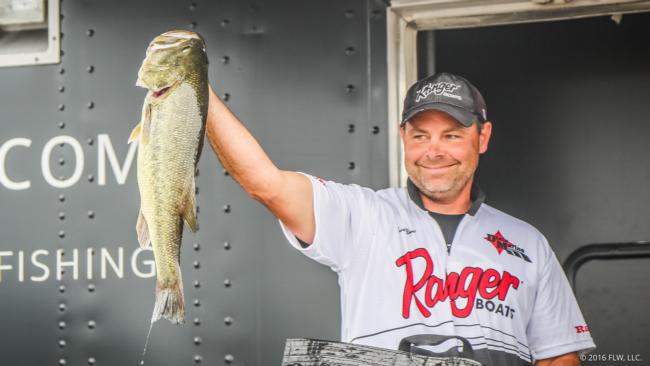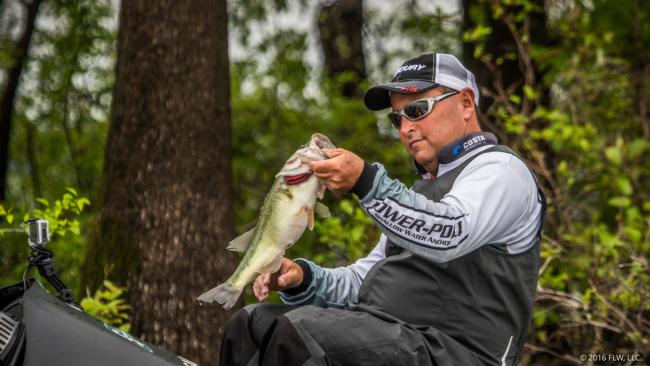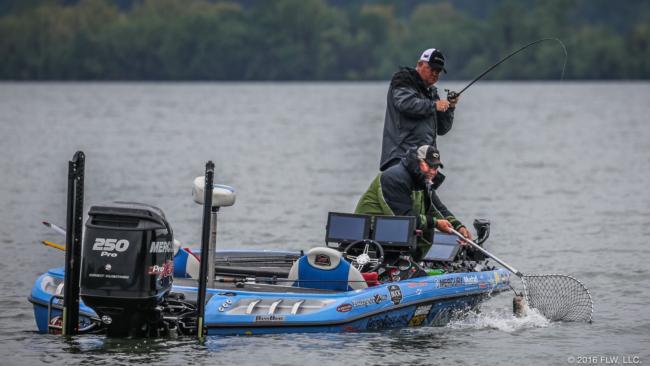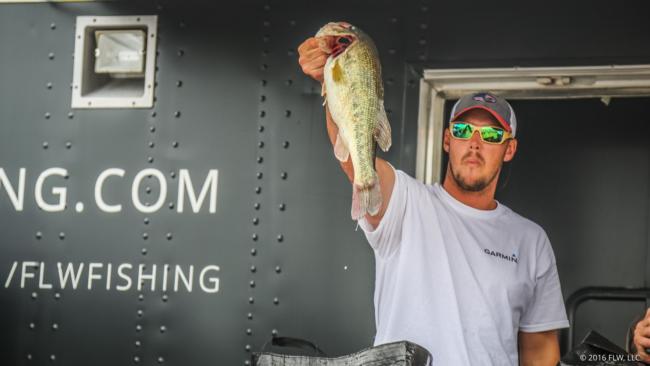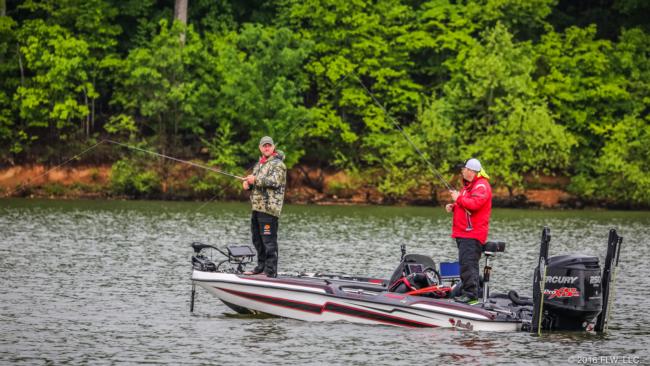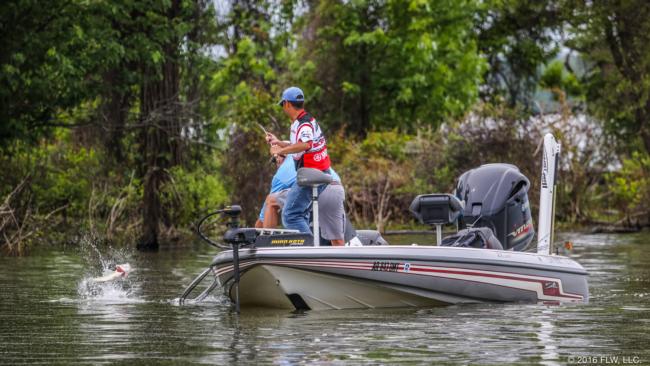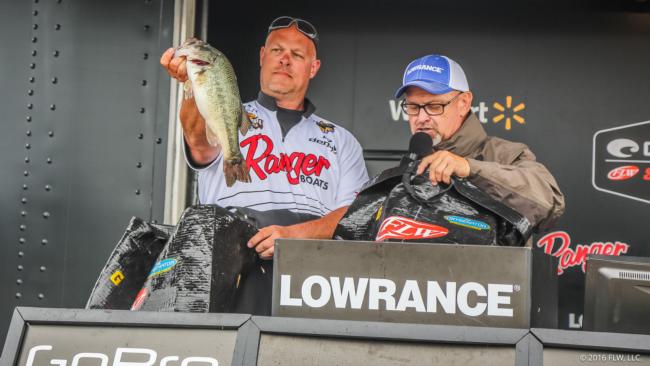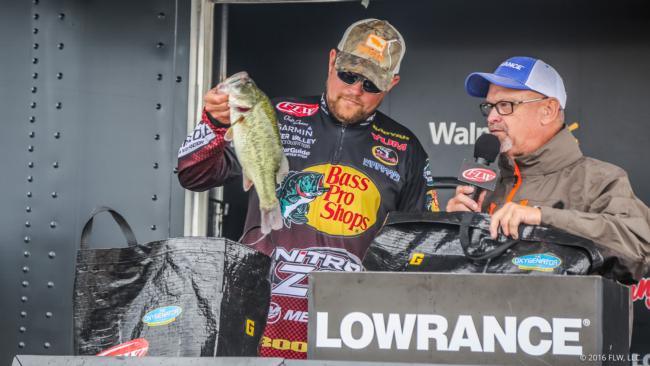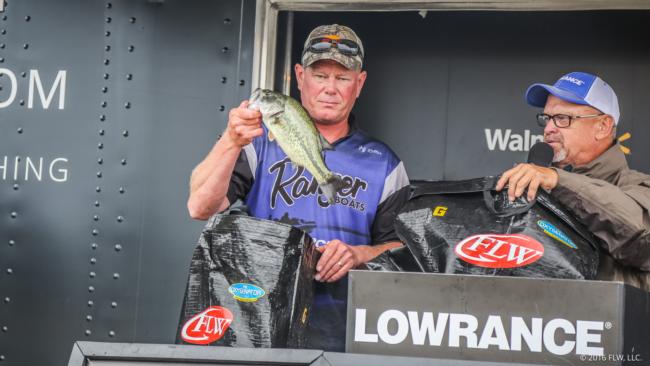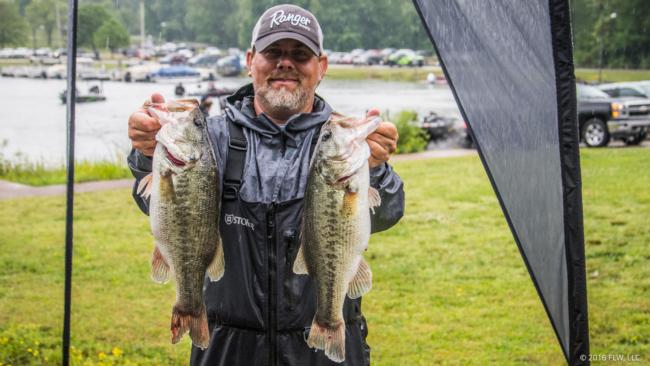Kentucky Lake Top 10 Patterns
The tactics that worked in late spring on the Tennessee River
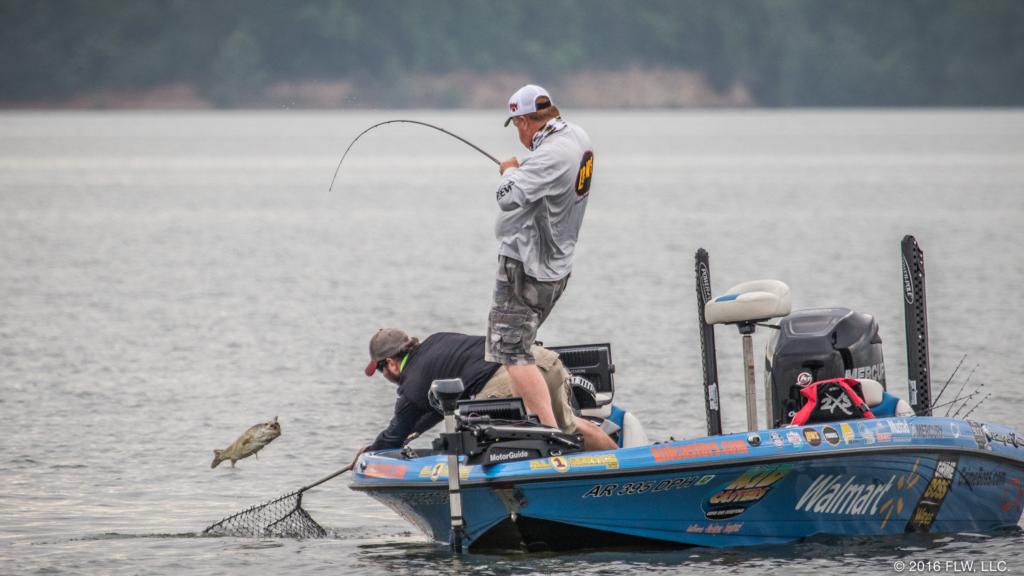
All week long at the Costa FLW Series Central Division event presented by Lowrance, Kentucky Lake seemed like a lake just on the verge of blowing wide open. New fish were moving into the shallows to spawn, and those that had come before them were trickling back out toward the main lake. In just a few days, 20-pound stringers of ledge fish will start showing up at weigh-ins. This time, making the top 10 meant navigating the transition and having faith that new fish would continue to arrive wherever a pro was fishing.
There were prespawn bass staging on primary and secondary points, bass feasting on spawning shad, spawners bedding around islands and in creeks, and postspawn bass on a variety of middpeth areas.
Steve Floyd of Leesburg, Ohio, managed it all better than anyone else. His three-day total of 51 pounds, 2 ounces was good enough for victory on a lake that didn’t quite show out to its full potential. Floyd caught his fish flipping shallow bushes with a Berkley Havoc Pit Boss.
Read on to learn how the rest of the top 10 got it done.
2. Colson flips bushes south of Paris
Ramie Colson Jr. is known as a flipper and pitcher on the Kentucky/Barkley system, but most people think he prefers to run to Barkley (the two lakes are connected) whenever he can. Colson says that’s not exactly the case anymore. He’s had better luck in recent seasons by flipping bushes and willows on main-lake islands and in spawning coves in Kentucky Lake’s southern third. That’s what he did at the FLW Series event to finish second with a three-day total of 50 pounds, 13 ounces.
Colson says he never really considered fishing any other pattern.
“On the Tennessee River until the second week of May, I’m flipping. Until the middle of May you still have a lot of fish going shallow,” he says. “This week with there being less water, I kind of put it [his pattern] together all week.”
In the final days of practice and the first two days of the tournament, the water dropped to a hair under 359 feet above sea level, which is considered full pool. Typically, the flipping bite is best at 360 to 361.
Colson had to run around a bit more to find areas with bushes that had enough water on them to flip. He says that instead of flipping in the heart of large clusters of bushes on flats and out in open water, he had better luck nosing his boat right up to the bank and flipping to isolated bushes sometimes in just inches of water.
Colson flipped a Zoom Z-Craw in the 420 color with a 5/16-ounce Reins tungsten weight and a 4/0 Gamakatsu Super Heavy Cover Flippin’ Hook. He used 20-pound-test Sunline Shooter Fluorocarbon.
“I’d pitch it in there and work it slow,” he says. “You really can’t cover a lot of water that way.”
All the pros who made the top 10 by flipping said that getting one big bite a day was critical for making the cut. Colson got his daily big bite. Unfortunately, a bit of bad luck on the final day might have been the difference in winning and finishing runner-up by just 5 ounces.
“I lost two 4-pounders today, but when you’re in that kind of stuff that happens,” he adds.
3. Rose combines a main-lake shad spawn, flipping and primary points for third
It wasn’t traditional ledge fishing that got Walmart pro Mark Rose to the top 10, but he did catch most of his big fish from a main-lake drop-off. Instead of a deep drop he found with electronics, the spot Rose fished was about 4 or 5 feet deep on top. Big smallmouths and largemouths were set up on it to feed on spawning shad.
The spot produced most of Rose’s day-one limit of 18 pounds, 2 ounces and several of his day-two fish. On day three, angling pressure spoiled the spot, and Rose had to adjust. He finished with 48-15 for third place.
Rose says the shad spawn spot was connected to a larger ledge that he’s fished throughout the years on Kentucky Lake. He dialed in on the exact spot in practice by just fishing his way along the drop.
“[In practice] I caught some with a Strike King Jointed Structure Head with a Strike King Rage Bug, and I had a lot of fish just bump me but not eat it. A lot of times those are smallmouths. Then I saw one bust [on the surface]. I picked up a spinnerbait and had shad follow it back to the boat,” he says.
The chasing shad clued Rose into the shad spawn, and that was the only spot where he could locate the spawn out on the main lake. He ended up catching his fish from the spot primarily with swimbaits.
Once he left that spot each day, Rose caught a few fish flipping a Rage Bug. On day three, he caught a number of fish from a point in the mouth of a spawning creek using a straight-tail worm on a jighead.
“Michael Wooley tipped me off to that,” Rose says about the straight-tail worm. “We had talked about seeing them [on the graph] but not being able to catch them.”
The fish on the point simply weren’t the right size to keep up with the flipping bite, which seemed to get better as the week went, and Rose fell to third behind Floyd and Colson.
4. Miranda commits to the bed-fishing bite
Russellville, Ark., angler Chris Miranda spent the entire tournament bed-fishing south of the bridge at Paris Landing. He wasn’t exactly sight-fishing but was able to see light spots from far away and knew them to be beds.
Miranda discovered a pattern for locating large spawning areas with big clusters of beds spread across shallow flats. He wouldn’t reveal exactly what he keyed on but says it’s similar to how he fishes this time of year on his home fishery Lake Dardanelle. He located five areas where he could duplicate the pattern.
Stealth was key. Instead of easing in close to try and see the fish on beds, Miranda sat back and bombed casts to the light spots. He says if he saw the fish, it was too late and he couldn’t catch it. This long-range approach allowed him to catch bass on beds even when conditions weren’t ideal for sight-fishing.
Miranda’s best day was day three, when he caught 17 pounds, 6 ounces to boost his total to 48-09.
“The first day, I probably shouldn’t have, but I caught my fish then left them,” he says. “The second day was a lot tougher. Today [Saturday], I caught every fish that bit. I had nothing to lose today. I went back to my first spot, and that first wave of fish – the first good wave – finally showed up, I think.”
Miranda started practice flipping a Reaction Innovations Sweet Beaver but realized he needed to downsize and spent the rest of the week flipping a Smallie Beaver in either sprayed grass or magic craw swirl.
“Earlier in the week during practice a lot of fish would nip at it,” he says. “I downsized everything to a 3/0 Skinny Bear Tackle Premium Heavy Wormin’ Hook and a 1/8-ounce weight. If they bit it [the Smallie Beaver] they had to get everything.”
5. Fox fishes the shad spawn for fifth
After he caught 24 pounds, 14 ounces on day two, Travis Fox was in the driver’s seat on Kentucky Lake. He led the tournament by about 5 pounds over Rose, who was in second place at the time. On the final day, instead of exercising patience and piecing together a limit, Fox believes he gave up on his fish too quickly. He thought he needed to catch more than 15 pounds to keep his lead, and when his bite was slow in the morning he panicked. Then a strong south wind made it difficult to fish some of his areas and navigate between them. He managed to catch only four fish for 7-12 and slipped to fifth place with 48-08.
A shallow main-lake bar where shad were spawning produced Fox’s big day-two limit.
“I just knew there were a lot of baitfish there,” he says. “I found it because I saw birds there.”
He also fished a spawning area and a staging area with large rocks on the end of a point where prespawn and postspawn bass would set up on their way in and out of spawning flats. His bigger fish came on a homemade hand-poured swimbait on a VMC Swimbait Jig. Fox also dragged a straight-tail worm on a VMC Rugby Jig.
“I did lose two today [Saturday],” he adds. “I set the hook on one, and it’d been raining real hard. I came plum out of my flip-flips, slipped and it came off.”
6. Kweekul takes AOY lead by cranking and flipping
Central Division Strike King Angler of the Year leader Daniel Kweekul made his second consecutive top 10 of the season by targeting two key spots.
“I had a small ledge, and also I was fishing bushes. Every time I’d leave the bushes I’d go back to the ledge, and it seemed like they’d reload,” says Kweekul, a recent retiree from the Army National Guard.
On the ledge, Kweekul fished a chartreuse/black back Strike King 5XD crankbait. The spot was 5 feet deep on top, and Kweekul says most of his bites came as the crankbait was breaking off the top into about 7 feet.
His flipping bite was on islands, and his best island was actually connected to the ledge where he cranked. Kweekul flipped a tramp stamp-colored Reaction Innovations Kinky Beaver or Yamamoto Senko, each rigged with a 1/4-ounce weight and 5/0 Gamakatsu G-Lock offset-shank worm hook.
“They pretty much hit it on the first drop. If I hopped it two or three times and one didn’t bite it, there wasn’t one there,” he says.
Kweekul finished up with 47 pounds, 9 ounces.
7. Schmitz flips for top 10
Hoosier pro Todd Schmitz was part of the flipping crowd at Kentucky Lake. He caught 46 pounds, 2 ounces to finish seventh.
Schmitz used a Reaction Innovations Sweet Beaver in the green goby color on a Mustad 3/0 hook and a similarly colored Zoom Brush Hog on a 4/0 hook. Both were rigged with a 5/16-ounce weight and 20-pound-test P-Line CXX monofilament.
“I had six places from Paris to New Johnsonville, flipping in the backs of pockets,” Schmitz says. “I eventually narrowed it down to two places. It seemed like there were 100-yard stretches that were really good.”
Key for Schmitz was finding deeper bushes in areas with a hard gravel or sand bottom.
“I let it [the bait] fall on a slack line. Then I just let it sit for a second,” he adds. “You had to be at the absolute base of the bush. It doesn’t matter what’s out in front of it. Some were easy to get to the base; some were near impossible.”
8. Jones power fishes with a trio of baits
For his second consecutive Central Division top-10 finish, Chris Jones of Bokoshe, Okla., power-fished with a trio of baits: a YUM Christie Critter, a bull frog-colored BOOYAH Poppin’ Pad Crasher and a 1/2-ounce Double Colorado BOOYAH Blade spinnerbait in white and chartreuse.
His daily limits went 15-06, 14-10 and 13-08, for a three-day total of 43-08.
“I caught lots of numbers, but no size,” says Jones, who was targeting willow trees on about 10 main-lake islands close to the main river channel near New Johnsonville. “I think it had to be at the mouth of a creek. I think a lot of fish were just coming out of those creeks.
“I think the key was just making sure the bait was up against the base [of the tree]. It could be 6 inches off and they wouldn’t eat it.”
9. Ritter keeps it simple around willows and grass
Jeff Ritter logged a ninth-place finish by targeting sparse clumps of grass on a large shallow flat and willow trees on main-lake islands.
Ritter used a homemade spinnerbait, a homemade jig and a beaver-style flipping bait.
“I had one area that had a mixture of willows and grass. I don’t know what kind of grass it was, but it grows up on stalks,” he says. “I threw the spinnerbait around the willows. On the first day I caught all my fish on the spinnerbait. It was sunny and bright, and they were tucked up tight to the willows. They jumped all over it.”
His three-day total weight was 40 pounds, 14 ounces.
10. Crankbaits carry Readhimer to 10th
Tennessean Kelly Readhimer was dialed in on a cranking pattern with a Strike King 6XD in chartreuse/blue back or citrus shad. He weighed in a total of 39 pounds, 4 ounces in three days.
“In practice I was going flipping, but the weights were going away and the water wasn’t high enough,” he says. “On Sunday I started cranking shell beds and river bars. I didn’t catch many, but when I caught one it was a big one. They were the right kind. They just ran out.”
Readhimer’s spots were 6 to 10 feet deep. New bass were coming in each day, but he says they weren’t really schooled up yet.
